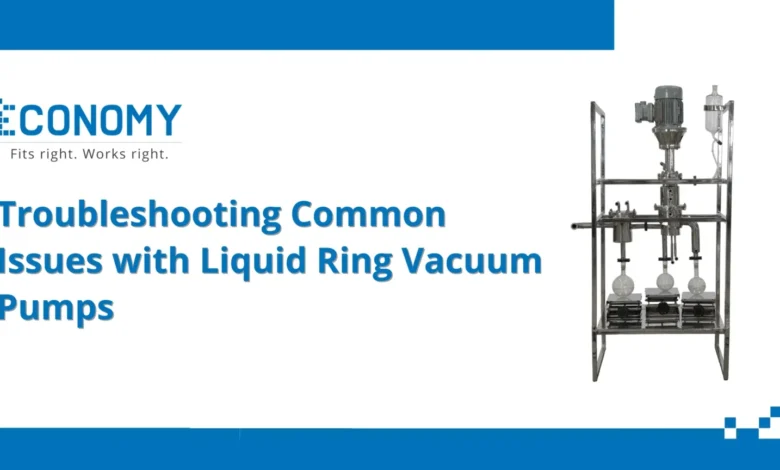Troubleshooting Common Issues with Liquid Ring Vacuum Pumps

Liquid ring vacuum pumps are essential in many industrial applications, offering reliable performance and the ability to handle a variety of gases, including wet and corrosive ones. Despite their robust design, these pumps can occasionally face operational issues that affect efficiency and performance. Understanding the working principles, types, features, and common problems of liquid ring vacuum pumps is crucial for maintaining optimal operation. This article delves into the intricacies of liquid ring vacuum pumps and offers a comprehensive guide to troubleshooting common problems, as well as best practices for maintenance.
How Liquid Ring Vacuum Pumps Work
Liquid ring vacuum pumps operate by using a rotating impeller inside a cylindrical housing, partially filled with liquid, typically water or oil. As the impeller rotates, the liquid is forced outward by centrifugal force, forming a liquid ring inside the casing. This creates small chambers between the impeller blades, where gas is trapped.
The rotation of the impeller causes these chambers to expand, drawing in gas from the suction port. As the impeller continues to rotate, the chambers contract, compressing the gas and pushing it out through the discharge port. The liquid ring acts as both a seal and a coolant, keeping the gases from escaping and ensuring efficient heat management during compression.
Types of Liquid Ring Vacuum Pumps
Types of Liquid Ring Vacuum Pumps are generally categorized into two types:
- Single-Stage Liquid Ring Vacuum Pumps: These pumps are designed for processes that require moderate vacuum levels. They have a single compression stage and are more suited to applications that handle higher volumes of gases. Their simplicity makes them cost-effective and easier to maintain but limits their ability to achieve deeper vacuums.
- Two-Stage Liquid Ring Vacuum Pumps: In contrast, two-stage pumps are designed for processes requiring deeper vacuums. These pumps compress gas in two stages, allowing for more effective gas removal at lower pressures. They are typically used in applications where a higher vacuum is needed and are more efficient in handling gases that condense at low pressures.
Features and Construction
Liquid ring vacuum pumps are known for their robust and simple construction, which allows them to handle tough applications. Some key features include:
- Impeller: A multi-blade rotor that creates the vacuum by rotating within the pump casing.
- Casing: A cylindrical housing that contains the impeller and the liquid ring. It’s typically made from corrosion-resistant materials such as stainless steel, which makes the pump suitable for handling corrosive gases.
- Sealing Liquid: A liquid, usually water or oil, acts as both a seal and a cooling agent, aiding in gas compression and temperature regulation.
- Inlet and Outlet Ports: These are designed to allow the gas to enter and exit the pump at precise moments in the cycle, ensuring smooth operation.
Performance and Maintenance
For optimal performance, several factors must be considered:
- Sealing Liquid: The correct amount and type of sealing liquid must be maintained for the pump to operate efficiently. The liquid should also be clean and free of contaminants that might clog the pump or reduce its efficiency.
- Temperature: The temperature of the sealing liquid can affect pump performance. Higher temperatures can reduce the vacuum level, while excessively cold liquids may cause condensation issues within the pump.
- Impeller and Bearings: Regular inspection of the impeller for wear and checking the bearings for proper lubrication are critical for maintaining performance.
Applications
Due to their versatility, liquid ring vacuum pumps are used in a wide range of industries, including:
- Chemical processing: Liquid ring vacuum pumps handle gases and vapors from chemical reactions, distillation, and drying processes.
- Food and beverage: These pumps are used for vacuum packaging, dehydration, and degassing liquids.
- Power generation: Liquid ring pumps are commonly used in steam condensation processes in power plants.
- Pharmaceuticals: Used for solvent recovery, drying, and distillation in pharmaceutical production.
- Petroleum refining: These pumps assist in vacuum distillation, vapor recovery, and other refining processes.
Troubleshooting Common Issues
Even though liquid ring vacuum pumps are reliable, issues can arise that impact their performance. Here are common problems and how to troubleshoot them.
1. Poor Vacuum Performance
Symptoms: The pump fails to generate the required vacuum level.
Causes:
- Insufficient sealing liquid level.
- Air leaks in the system.
- Worn or damaged impeller blades.
- High temperature of the sealing liquid.
Solutions:
- Check the level of the sealing liquid and top it up if necessary.
- Inspect the system for air leaks, especially around seals, flanges, and connections.
- Examine the impeller for signs of wear or damage and replace it if needed.
- Ensure that the sealing liquid is at the correct temperature for the application.
2. Cavitation
Symptoms: Unusual noise and vibrations, often accompanied by a drop in vacuum efficiency.
Causes: Cavitation occurs when the sealing liquid is insufficient, or the pump operates at too low a pressure, causing vapor bubbles to form and collapse inside the pump.
Solutions:
- Increase the amount of sealing liquid to prevent cavitation.
- Adjust the operating pressure to stay within the pump’s optimal range.
- Check the pump’s speed and ensure it is operating within the recommended RPM range.
3. Overheating
Symptoms: The pump casing becomes excessively hot, and the sealing liquid evaporates too quickly.
Causes: Overheating can occur due to a lack of cooling liquid, excessive load on the pump, or inadequate ventilation around the pump.
Solutions:
- Ensure an adequate supply of cooling liquid.
- Reduce the pump’s workload or use a larger pump that can handle the required capacity.
- Improve ventilation and airflow around the pump to dissipate heat more effectively.
4. Excessive Power Consumption
Symptoms: The pump consumes more energy than expected during operation.
Causes:
- Excessive internal friction caused by worn bearings or impellers.
- Inadequate lubrication.
- Improper alignment of the pump.
Solutions:
- Inspect and replace worn bearings or impellers.
- Check the lubrication of the pump’s moving parts and ensure proper oil levels.
- Ensure that the pump is properly aligned with the drive motor to reduce strain.
5. Liquid Carryover
Symptoms: Liquid is carried over into the discharge port, contaminating downstream equipment or processes.
Causes:
- Excessive sealing liquid inside the pump.
- High operating speeds.
- Inappropriate sealing liquid for the application.
Solutions:
- Adjust the level of sealing liquid to the manufacturer’s recommended level.
- Reduce the operating speed to prevent liquid carryover.
- Ensure that the sealing liquid is suitable for the specific application.
6. Vibration and Noise
Symptoms: The pump produces loud noise or vibrates excessively during operation.
Causes:
- Cavitation.
- Worn or unbalanced impeller.
- Loose components or improper installation.
Solutions:
- Address cavitation as described earlier.
- Check and balance the impeller, or replace it if it’s worn.
- Tighten any loose bolts or components and ensure the pump is installed correctly.
Encouragement for Proper Maintenance and Troubleshooting
Regular maintenance and prompt troubleshooting are essential to the efficient operation of liquid ring vacuum pumps. Establishing a preventive maintenance schedule can help detect issues early before they lead to costly repairs or extended downtime. Maintenance tasks such as checking the level and quality of the sealing liquid, inspecting the impeller for wear, and ensuring proper lubrication of moving parts should be performed at regular intervals.
By following troubleshooting guidelines and performing routine maintenance, operators can extend the life of their liquid ring vacuum pumps, reduce the frequency of breakdowns, and ensure consistent performance in demanding applications. Proper care also improves the safety of the system and enhances overall plant efficiency.
Conclusion
Liquid ring vacuum pumps are vital for various industrial applications, and their efficiency and reliability depend on proper maintenance and troubleshooting. By understanding how these pumps work, recognizing the types available, and knowing how to address common problems, operators can maximize their performance and lifespan. Encouraging a culture of proactive maintenance ensures that liquid ring vacuum pumps operate smoothly, delivering consistent vacuum levels and handling complex gas streams in industrial environments.

